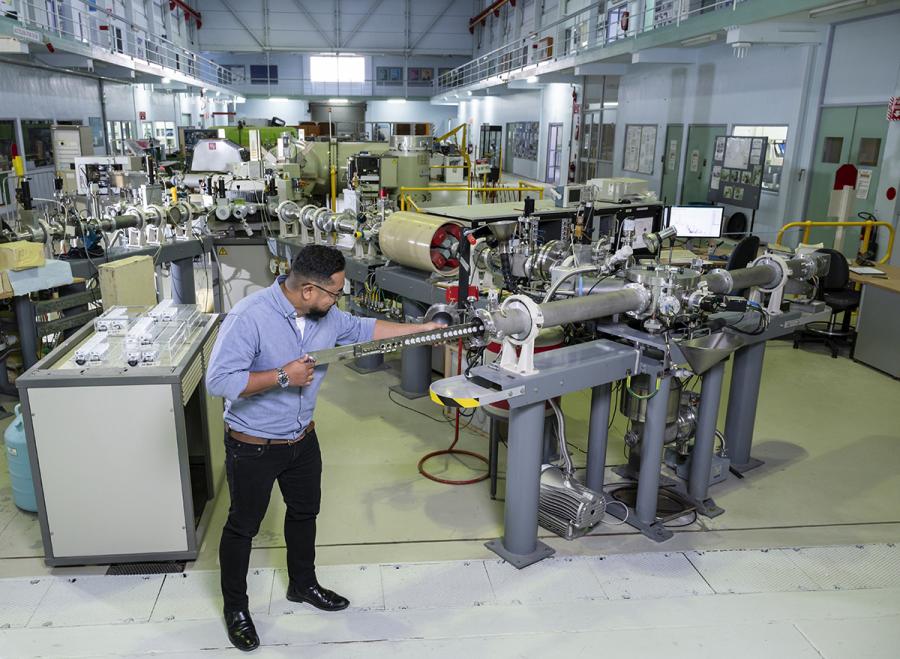

Published on the 7th October 2022 by ANSTO Staff
Key Points
-
ANSTO is supporting an industry-led initiative to identify and phase out PFAS chemicals in food packaging
-
Although PFAS chemicals have useful properties they are potential environmental pollutants
-
Nuclear technique on the STAR accelerator can detect and measure the presence of fluorine, an indicator of PFAS
Testing at ANSTO’s Centre for Accelerator Science supports an action plan just published by the Australian Packaging Covenant Organisation (APCO) to phase out per- and polyfluoroalkyl substances (PFAS) in fibre-based food contact packaging in Australia by December 2023.
PFAS compounds have a range of useful applications but are very resistant to degradation in the environment, which makes them potential environmental pollutants.
The new voluntary industry-led initiative provides guidelines to assist businesses in undertaking testing for fluorine – the F in PFAS - which is an indicator for the presence of PFAS.
A non-destructive, highly accurate and precise technique, known as particle-induced gamma-ray emission (PIGE), undertaken on the STAR accelerator at ANSTO’s Centre for Accelerator Science can detect trace amounts of fluorine concentration down to 50 parts per million (ppm).
This type of analysis is known as non-targeted screening, and the service is now available to research and industry users across Australia and overseas with rapid turnaround response times at ANSTO’s Centre for Accelerator Science.
“Our technique doesn't detect specific PFAS compounds, it measures the total fluorine concentration,” explained Dr Armand Atanacio.
“With traditional analytical chemistry techniques used for detecting specific PFAS compounds, it would be quite the task to screen for more than 9,000 compounds identified as a PFAS in each sample.
“Our approach is both time-saving and cost-saving,” Dr Atanacio added.
“STAR can run through a hundred samples in a short period of time non-destructively. This is usually about 10 to 15 minutes per sample.
“If we get 100 lines of food packaging, we can analyse all of those within a few days, provide the results and indicate which of those samples have elevated fluorine which suggests the presence of PFAS. The business could then focus on those 10 or 20 samples for further targeted testing.”
“On the other hand, the samples with no fluorine measured above our 50 ppm detection limit indicate there is likely no PFAS present.
“This testing will assist the regulators as well, as they are trying to set a limit in terms of what is acceptable total fluorine concentration in parts per million.
“Currently, above 100 parts per million total fluorine concentration is considered likely to contain intentionally added fluorine, and below that is likely remnants from recycled material that contains fluorine.
“The majority of the samples we receive are cellulose-based packaging, such as boxes for pizza, burgers and chips, but also a new stream of packaging made from sugar cane pulp called Bagasse,” said Dr Atanacio.
“From the 2021 pilot study we undertook with APCO, the highest levels of fluorine, above 800 ppm, were found in this sugarcane-based packaging. This is concerning as Begasse packaging is often marketed for its compostable features,” he added.
“Our PIGE technique can also be used for materials other than food packaging, such as fabric.”
“This is a great example of ANSTO nuclear and accelerator techniques rising to an industry challenge and pivoting our applications to provide a solution quickly. We are pleased to be working with APCO, who have responded to an Intergovernmental position on PFAS with their comprehensive plan,” said Dr Ceri Brenner, Leader, Centre for Accelerator Science.
“Details for contacting us have been included in the plan and are available on our website.”
It is designed to support businesses with the process of identifying PFAS in fibre-based food contact packaging and a pathway to phase it out.
In addition to a guide on how to test for total organic fluorine (TOF), the plan includes a step-by-step outline of how to report on the PFAS present in fibre-based food contact packaging.
Chris Foley, CEO, APCO commented: “The release of the PFAS Action Plan highlights our commitment as an industry to understand the knowledge gaps around substances like PFAS and to come up with collaborative solutions.”


